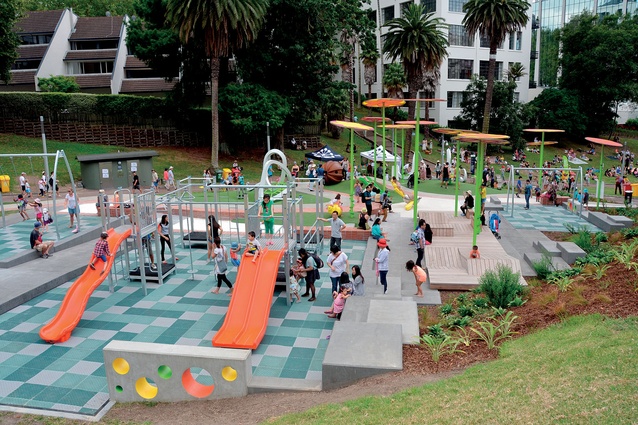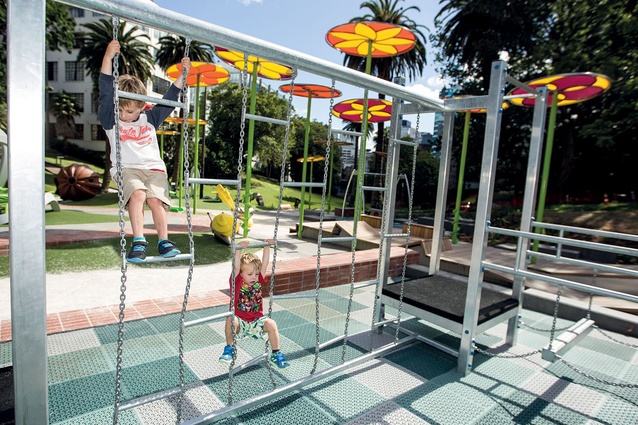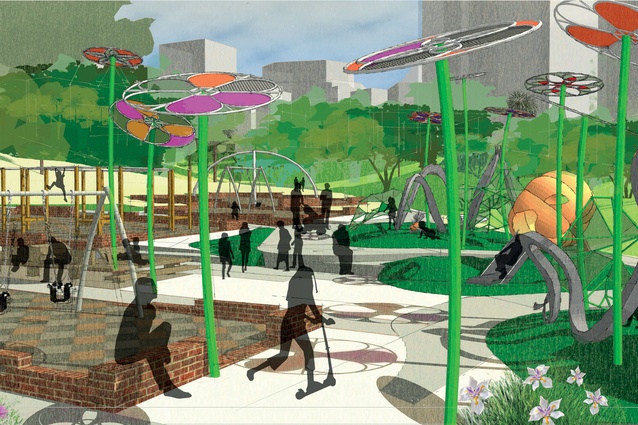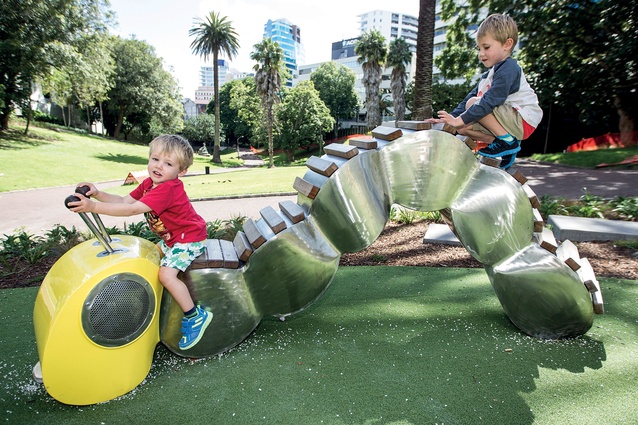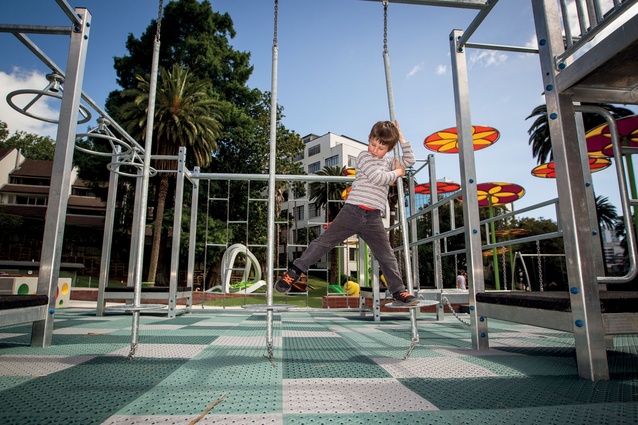Myers Park
Nestled between the inoffensive convention of Aotea Square and the less salubrious environs of Karangahape Road, a small valley of surreal giant flowers, oversized caterpillars and colourful interactive elements evokes memories of Willy Wonka and Alice in Wonderland – childhood tales with a fantastical, slightly skewed point of view that has endeared them to generations of children.
This new playspace at the heart of Myers Park is an integral component of a master-planned renewal, designed to reimage the inner-city park as a high quality shared urban backyard. For the team at Isthmus, it was an opportunity to create a new place for the children of the neighbourhood. And for the children who fill the space during the day and at the weekends it is a rambling garden in which they can let their imaginations run wild.
Under an abstract canopy of bright and colourful disc-shaped flowers, they can swing, crawl and climb through a meandering network of ‘pumpkin vines’ and large grid-like ‘leaves’, slide through a large ‘kamokamo’ eaten by caterpillars, or clamber over giant garden birds and insects, with interactive features.

It’s actually quite a small space, but when seen from a child’s point of view, the grand scale of the sculptural pieces engenders a different perspective of relative place and size. Creating this alteration in a physical sense can open up a realm of possibilities in the imaginative sense, says lead designer Haylea Muir. And the sculptural elements play a key role.
“The interactive flora and fauna elements were fabricated by our long-term collaborator Cicada Works. They’ve helped us produce giant bespoke play elements in other spaces at Wynyard Quarter, Barry Curtis Park and Hobsonville Point,” she says.
“Sometimes people have questioned the value of sculptures. But in a play space, these are the non-prescribed elements – in other words, there is no specific purpose for them. That’s the point. Adults don’t always appreciate that. But the children who use this park, use them when they play – they’re inspiring, they’re a launching point for imagination.”
The playspace is designed to be used by all ages. The folded timber decking provides an ideal platform for parents and caregivers to retreat for relaxed observation and a friendly chat. Low walls and grab-able surfaces at a low height allow toddlers to practice their balancing and stepping independently. Soon they will be running and hopping on the textured undulating surfaces.
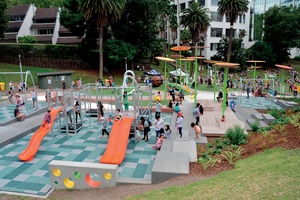
More adventurous preschoolers can play hide and seek with the peephole walls, race their scooters down the winding, sloping paths, or create fantastical make-believe adventures involving the garden creatures. Older children can take on the physical challenges offered by climbing equipment or move to the the adjacent grass slope and lawn for kicking a ball. Numerous climbing frames and a giant nest-basket swing are destined to be popular with groups of energetic kids.
Project lead Helen Kerr says all these components tie back to the ‘Play in the Backyard’ theme that was developed at the outset. “The whole idea behind the larger redevelopment plan was to bring this space back to the original intent when it was donated by Arthur Myers – a family park. So from that, within the playspace, our creative concept became ‘Play in the Backyard’. In cities, this idea is especially important – because historically (and in the future), these urban parks are, in fact, the shared backyard of the neighbourhood.”
It is a goal of the Waitemata local board’s development plan that Myers Park can be a substitute backyard for inner-city dwellers with a fun place to play, get exercise and learn about nature. The revitalization of the park and improvements to safety are an important step in realigning the park with Sir Arthur Myers original intention that ‘nature should be brought as near to our citizens and their children as possible’.
The playspace, coupled with redesigned entrances, planting, lighting, furniture and CCTV installation led by Council’s design team will put Myers Park back on the map as a safe and healthy part of Auckland. But those considerations are far from the minds of the youngest users, gathered under the dappled, colourful shade of three- to six-metre-high flowers. Even the name “Myers Park” means very little to a three year old. “The Park with the Giant Flowers” is something much more important.

